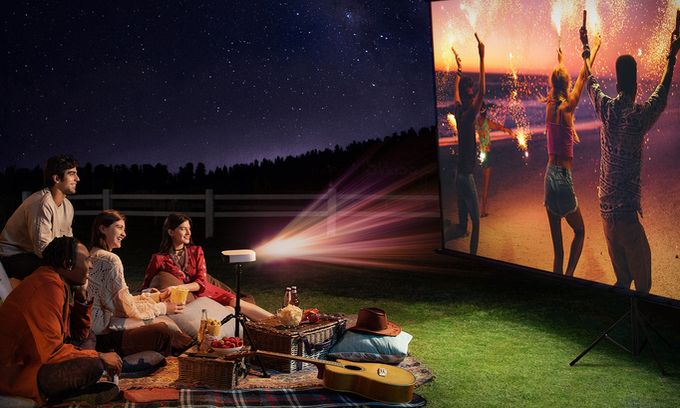For a decade now, projectors have been the fastest growing segment among home entertainment devices. However, this is due to several quite objective factors, including:
– SSL-based light engine (LED or laser solid state light source) heats up little, providing a compact design due to the absence of the need for heat dissipation;
– streaming, Chromocast and screen mirroring technologies solved the content problem for the projector;
– significant price reduction of 4K DLP models with XPR (Xpanded Pixel Resolution) technology from Texas Instrument.
Using 2- or 4-phase pixel shift, TI’s relatively cheap 1080p DMD (Digital Micromirror Device) XPR chipset displays 4K-image using only 2 mln micromirrors. In fact, the projector divides the original 8 mln pixels into 4 parts and sequentially plays 4 separate 1080p frames diagonally shifted by half a pixel from each other. Our vision perceives them as one clearer picture, ignoring the micro-delay due to high frequency. For pixel shift, the projector uses the lens tilt with 4 electromagnets of the XPR module;
– mid-focal models are placed in the center of the room, which is accompanied by laying wires along the floor. Today this problem is solved only with a complex ceiling mount. UST (ultra short throw) projectors create a large projection from a very short distance without creating this problem.
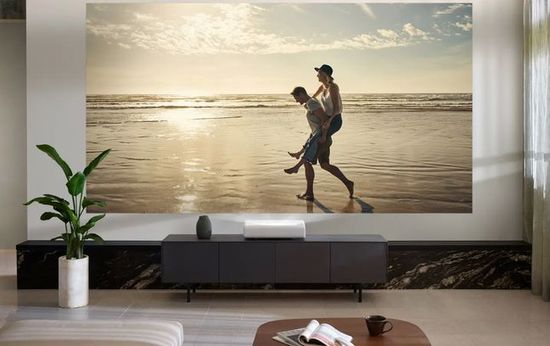
As a result, modern UST models compete very successfully with TVs as their alternative in the living room.
Of course, companies respond adequately to consumer rush. Today their range includes gaming models (input lag of several ms), UST ‘laser TVs’ for living rooms, ultra-compact ‘pocket’ projectors weighing several hundred grams and brighter portable ‘outdoor’ devices. Anker Nebula Mars 3 Air and ASUS ZenBeam L2 are the most interesting in the segment of new portable 1080p LED projectors.
Mars 3 Air
It’s a cheaper version of last year’s Mars 3:
– $ 480 vs $ 750;
– 400 ANSI lumens vs 1,000 ANSI lumens;
– 3.7 lbs vs 9.9 lbs weight;
– 2x 8W vs 40W internal speakers;
– 2-3 hours vs 5 hours battery life.
The model has a carrying handle.
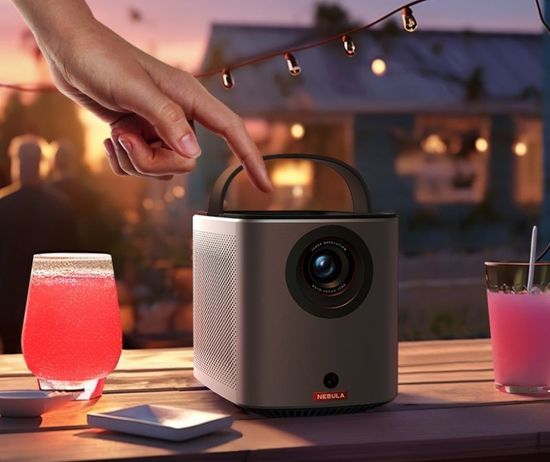
Unfortunately, the model does not have a pull-out leg for height adjustment. However, the projector has a threaded attachment point for an optional tripod at a cost of ~$ 50 (4.5″ height and ±12° tilt adjustment).
The Mars 3 Air uses 0.23-inch DLP imaging chip and supports full HD (1,920 x 1,080) resolution.
Color gamut reaches almost 90% in sRGB, and 73% of DCI-P3 color space, which is typical for this class.
After turning on, the projector projects five checkerboard images. Using front camera and sensor, it focuses and frames the image with auto keystone, auto screen-fit and auto obstacle avoidance. As usual, keystone correction is not available for Game mode.
Traditionally for portable models, Mars 3 Air uses the lens with a 1.2:1 throw ratio with manual digital zoom, butwithout optical zoom. Formally, its projection size varies in the range of 30-150″ diagonally. But even in the dark, acceptable image clarity and color saturation are available on a screen only up to 80″ due to low brightness (400 ANSI lumens).
Battery 52Wh provides over 3 hours of playback in Eco mode (145 ANSI lumens brightness), and just over 2 hours in the full power Standard mode. For visual charge control, the model has a four LED on top. In addition, the model has an ‘Auto’ setting to switch into Eco mode in the absence of a power supply.
Controls and smart platform
The projector offers Standard, Movie, Conference and Game picture modes. But Game mode is activated only when using the HDMI port. The contrast, color saturation, sharpness and color temperature settings are saved only in Custom mode. Also, projector adjust colors when using a colored wall as a screen, and offer three Gamma settings for Normal, Dark and Bright rooms.
The Expert Settings expands these with several noise reduction options and the DI Film mode. As known, it creates high-definition images encoded at 24 frames per second.
Testing confirmed 400 ANSI lumens brightest in Conference mode, but its color balance is slightly biased toward green. In Standard mode with more optimal color balance brightest decreases slightly to ~385 ANSI lumens. In the warmer Movie mode it’s 370 ANSI lumens. For comparison, most competitors lose up to 30% of brightness in Standard or Normal modes.
Unlike most modern Android projectors, Mars 3 Air has a Google TV platform with support of certified Netflix app. The dedicated buttons on the remote provide direct access to Amazon Prime Video and Netflix apps. The Home screen contains ‘For You’ tips, Live TV (almost 120 free streaming channels), Apps and a Library of movies and shows, Nebula Life (atmospheric videos or a projected clock), Play with video tips and tricks, links for Disney+, Hulu, HBO Max and Apple TV+. Streaming content is available via the Chromecast-enabled apps or Anker’s Nebula Cast app.
Controls includes four-way control, actuation button, go-back key, button for connecting to Bluetooth wireless speakers and keys to adjust the volume.
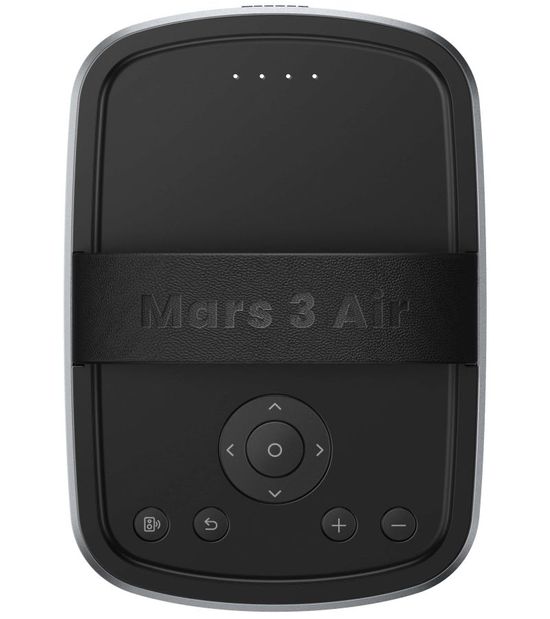
The Mars 3 Air supports Nebula Connect phone app for Android and iOS devices. It offers an on-screen keypad for text entry and a touchpad for moving the arrow across the screen.
ASUS ZenBeam L2
The projector was announced at CES 2023 and presented in August last year.
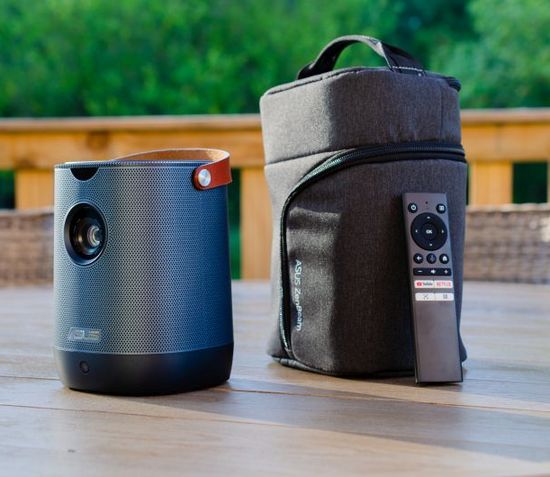
It became an improved version of L1 (L2 vs L1):
– $ 640 vs $ 300;
– 400 ANSI lumens vs 300 LED lumens (120 ANSI lumens);
– 1080p vs 720p resolution;
– 3.5 lbs vs 1.3 lbs.
L2 comes with free Google-certified Hako Android TV box with preloaded Netflix.
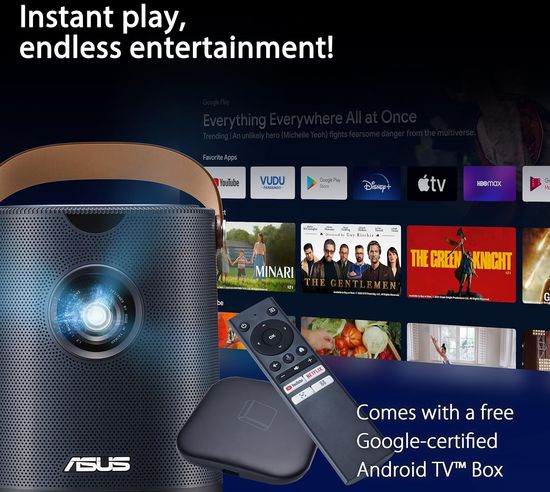
It’s a mini modular TV streaming system for major services, including Netflix and YouTube.
The model is slightly lighter than Mars 3 Air (3.7 lbs) and has a threaded attachment point for a tripod or ceiling mount. But it has a pull-out foot to adjust the tilt by 4° or 8°.
Like its competitor, the projector optimizes the image with five black and white templates, front-mounted camera and sensor.
The list of settings includes traditional auto geometric-correction (4-corner correction with horizontal and vertical keystone adjustments), auto-focus (built-in focus sensor), and obstacle avoidance (zooming or projection shift).
Projector has 0.23-inch DLP imaging chip and supports full HD (1,920 x 1,080) resolution. But unlike Mars 3 Air, it can also receive a 4K signal. In this case, the projector lowers its resolution and reproduces a 1080p image. In fact, this option expands the range of available content, allowing the projector to reproduce a 4K signal in Full HD resolution.
Traditionally for this class, L2 does not have an optical zoom lens. It has 1.2:1 throw ratio and produces an image of 40″-120″ diagonally.
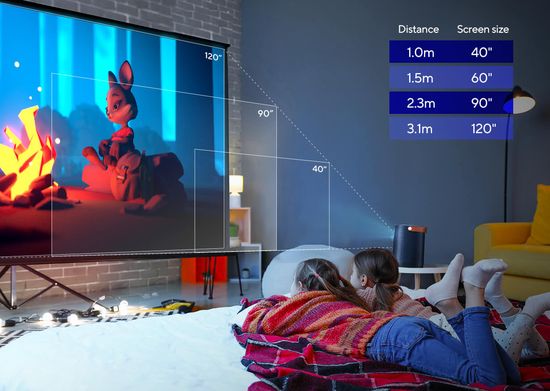
However, to be fair, a light output of 400 ANSI lumens will provide acceptable image quality up to about 80″ in size. With further increase in projection, the picture will become blurry and faded with dull colors.
Picture modes
Model does not have a dedicated Rec. 709 or sRGB setting, but according to the company, its color gamut reaches 99.5% of the sRGB.
ZenBeam uses Bright, Standard, Theater and User picture modes, and offers Scenery, Game and Eco settings. Peak light output in Bright slightly exceeds 450 ANSI lumens. Unfortunately, its balance is traditionally shifted towards green. In other modes, the projector provides good color accuracy. Standard mode with a light output of just under 290 ANSI lumens provides optimal compromise for overall brightness and color balance. The warmer Theater mode is more natural, but its brightness is reduced to 275 ANSI lumens. Scenery and Game modes use Cold and Normal color temperature, settings 80% brightness and contrast 50%. But due to insufficient brightness, acceptable image quality requires good dimming.
Unfortunately, Game mode does not reduce input lag, which reaches almost 80 ms for 1080p@60Hz. Therefore, the model is only suitable for casual slow-moving games.
A 65 watt-hour battery pack can operate in Low, Middle and High Battery Modes, providing up to 3 hours of playback.
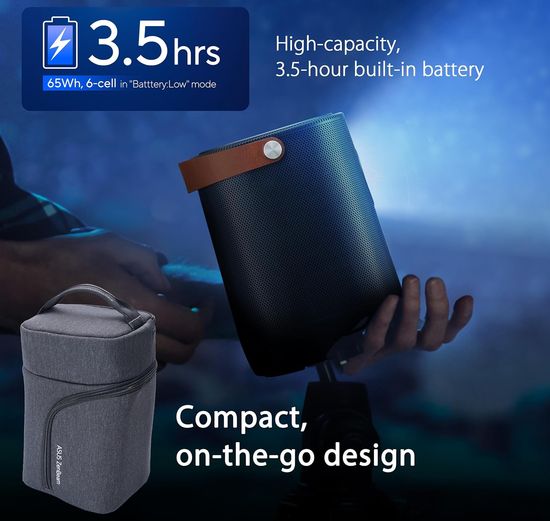
For example, the projector with Battery Mode Middle setting from HDMI input worked for 170 minutes, and the recharge time was about 2 hours.
Hako mini TV box and controls
The coating of the mini TV box is made to look like polished basalt. Depending on the memory, the price of analogues on the market starts from $ 50. The version of L2 has an Amlogic S905Y4 processor, 2GB of RAM and 16GB of storage space. In addition to Netflix, Google Play, YouTube and Amazon Prime services, Android TV 12 offers installable apps for HBO Max, Paramount+ and Disney+. Of course, it also supports other services, including, for example, Tubi or the Crunchyroll anime service.
To be fair, using a more versatile media streamer instead of an OS is gaining popularity. For example, Nomvdic P2000 comes with a Fire TV 4K Max dongle. Indeed, the Hako mini TV box can be used with any device, which is an added bonus of ~$ 50.
Controls on top provides a set of standard functions. However, the joystick for adjusting volume (right / left) and focusing (up / down) seems like a good solution.
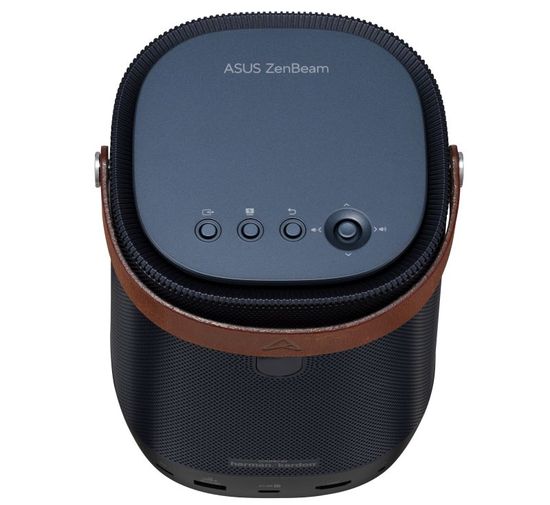
But its operation requires a tight fit of the lid.
The remote supports all popular functions, including on/off, selection of HDMI input / Android TV / USB-C video, etc with the help of a four-way control (Menu navigating), Android TV Home button, volume control, direct YouTube / Netflix links, and mic button for Google Assistant.
In addition, the projector has a Light Wall option offering 26 choices for ambient projections (aurora borealis, digital shadows, etc).
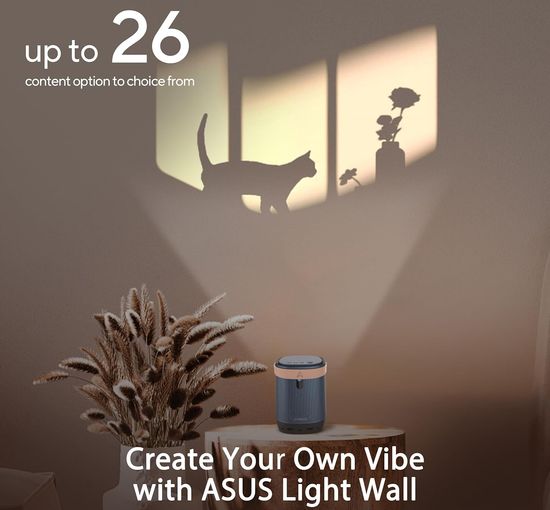
Conclusion
In general, the specs and functionality of the models are almost identical. Both projectors use Wi-Fi and Bluetooth 5.1, 0.23-inch DLP imaging chip with Full HD 1080p resolution and LED light sourse. It provides peak brightness up to 400 ANSI lumens (accordance with ANSI IT7.228) or 960 LED lumens.
Weighing in at 3.5 Lbs, portable in size, and with a 2 to 3 hour runtime, they’re perfect for a camping trip or watching baseball games with friends in the backyard.
The list of differences is very short (Anker Mars 3 Air vs ASUS ZenBeam Latte L2):
– $ 480 / £ 450 in UK vs $ 640;
– Google TV platform with certified Netflix app vs Google-certified Android TV box with preloaded Netflix;
– internal speakers – 2x 8W vs 10W (Harman Kardon setting);
– color gamut – 90% vs 100% in sRGB or Rec. 709 color space;
– only 1080p input signal vs can receive a 4K signal with playback in 1080p resolution.
Considering the price starts at $ 50 for an Google-certified Android TV box, the ASUS is only slightly more expensive. It offers a wider color gamut, the ability to receive 4K content and audio system settings by Harman Kardon, which is quite adequate for the slight price difference. However, even a slight discount can change this ratio.
List of closest competitors:
– Xiaomi Mi Smart 2 – $ 600, April 2022, 500 ANSI Lumens, LED, 1080p, 2.9 lbs;
– XGIMI Halo+ – $ 650, September 2021, 550 ANSI Lumens, LED, 1080p, 3.5 lbs.
This video introduces ASUS ZenBeam L2 smart portable LED projector.
